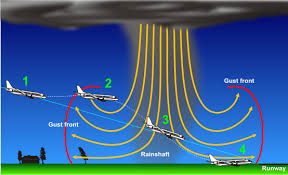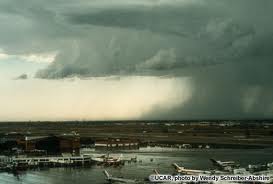Here’s an anniversary worth marking! It’s been 20 years to the day since a thunderstorm downburst last triggered a commercial jet crash. Mike Smith, Sr. Vice President of AccuWeather Enterprise Solutions, this morning published a nice guest post on the Capital Weather Gang’s blog, describing the meteorology of downbursts and recounting the history of the memorial event.
Mr. Smith’s vivid and thorough account is worth reading in its entirety. Here’s a smidgen of background, followed by a few additional personal observations. To start, picture a rain shaft from a severe thunderstorm:
Rain is falling at such a rate it’s as if you pointed a garden hose at the floor. The resulting splat pattern produces outflow in every direction. Under the right conditions, major storm outflow wind speeds can exceed 100 mph. Any pilot/plane entering such a wind pattern, from any compass direction, first experiences an increase in airspeed (speed of the plane relative to the air) of a like amount. In this entry-phase, pilots on takeoff find themselves rising more rapidly than expected. Pilots attempting to land are tricked into thinking they’ll overshoot the runway.
The great temptation is to throttle back. But just as suddenly, as pilot and plane pass through the center of the downburst pattern to the other side (again, regardless of direction, because the downburst pattern is symmetric) and encounter a reduction in air speed of similar amount. Because aircraft at takeoff and landing are flying relatively slowly, at speeds something like 150-200 mph, the speed relative to the air has just dropped, from as much as 250 mph to 50 mph.
But the lift on the plane’s wings is proportional to the square of the airspeed. A drop in airspeed of a factor of as little as a factor of two is a loss of lift of a factor of four. The resultant loss of lift is so great it’s as if the wings had fallen off the aircraft. For turboprop aircraft, this encounter is bad enough. The bumps are horrific; the pilot has to scramble to recover the proper engine and aircraft configuration. But in jet aircraft, the situation is even more dire. Depending on the equipment, the turbines can take 20-30 seconds to spool up again to full power. That’s time that the pilot on takeoff or landing doesn’t have. The plane crashes. As Mr. Smith documents, as jet aircraft became the standard means of air travel, the number of events was significant and sobering. Here’s his list:
- Continental Airlines Flight 426, Denver, 1975
- Allegheny Airlines Flight 121, Philadelphia, 1976
- Continental Airlines Flight 63, Tucson, 1977
- USAir Flight 179, Dayton, 1982
- Pan American Flight 759, New Orleans, 1982
- USAir Flight 183, Detroit, 1984
- United Airlines Flight 663, Denver, 1984
- Delta Airlines Flight 191, Dallas-Fort Worth, 1985
Mr. Smith nicely retells the story of the meteorological detective work and action by the FAA and the aviation industry that has reduced this threat over the years.
Social science is receiving more and more attention these days, so perhaps four aspects to the social side are worth mentioning:
Human technological advance created a wholly novel societal threat. Prior to aircraft flight, and jet aircraft flight in particular, downbursts were destructive (as evidenced by the microburst event that hit the Belleview area of south Alexandria on June 18) but not nearly so deadly.
Understanding the science is not enough. Scientists must also act with courage and with social grace if they’re to warn of threats in a way that spurs people to act. Mike Smith and Jason Samenow display these traits today, but the heroes of the downburst story from decades ago are Ted Fujita (whom Mr. Smith appropriately acknowledges) and also John McCarthy, formerly of the University of Oklahoma and the National Center for Atmospheric Research. For a glimpse of Mr. McCarthy’s role, interested readers might check out this article from the New York Times in 2005. While working with the FAA and the aviation sector to cope with this particular threat, Mr. McCarthy also established what is today NCAR’s Research Applications Laboratory. RAL continues to support aviation, but also harnesses atmospheric research for human benefit across a broad array of sectors. (Not coincidentally, RAL is also administrative home to most of NCAR’s cohort of social scientists).
Terminal Doppler Weather Radars are important but not the whole story. Mr. Smith’s guest post hints at this. Even before the TDWR network was fully installed, the accident rate started to decrease, thanks to growing pilot awareness. That’s because Mr. McCarthy and others programmed the downburst wind structure into flight simulators. Commercial pilots trained in the simulators quickly learned after “dying” a few times that they didn’t have the right stuff needed to survive a downburst encounter. Armed with training on identifying the dangerous weather patterns visually, they quickly became adept at detecting and avoiding the threat:
We would do well to emulate this behavior in the face of other weather, water, and climate risks. All that is required is the same national will. NOAA’s nascent Weather-Ready Nation program is a step in the right direction.
Happy anniversary!



